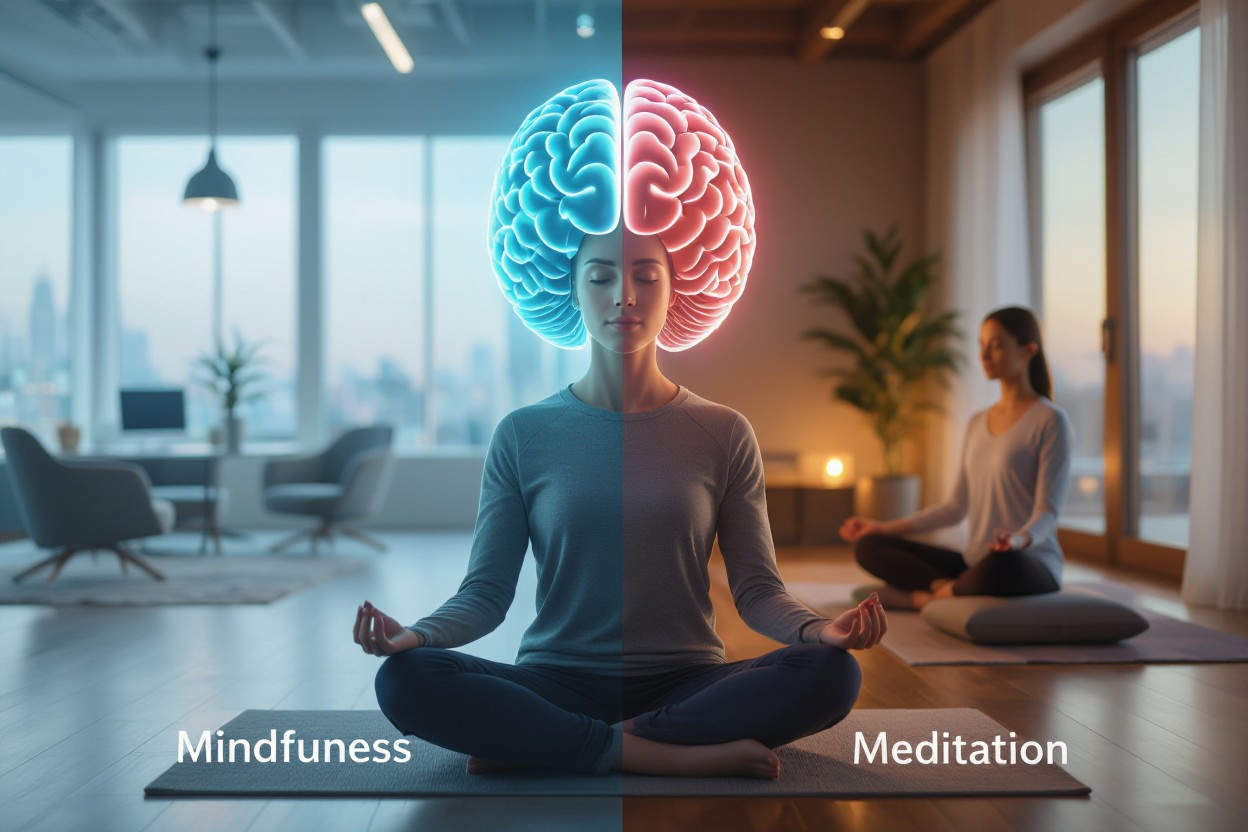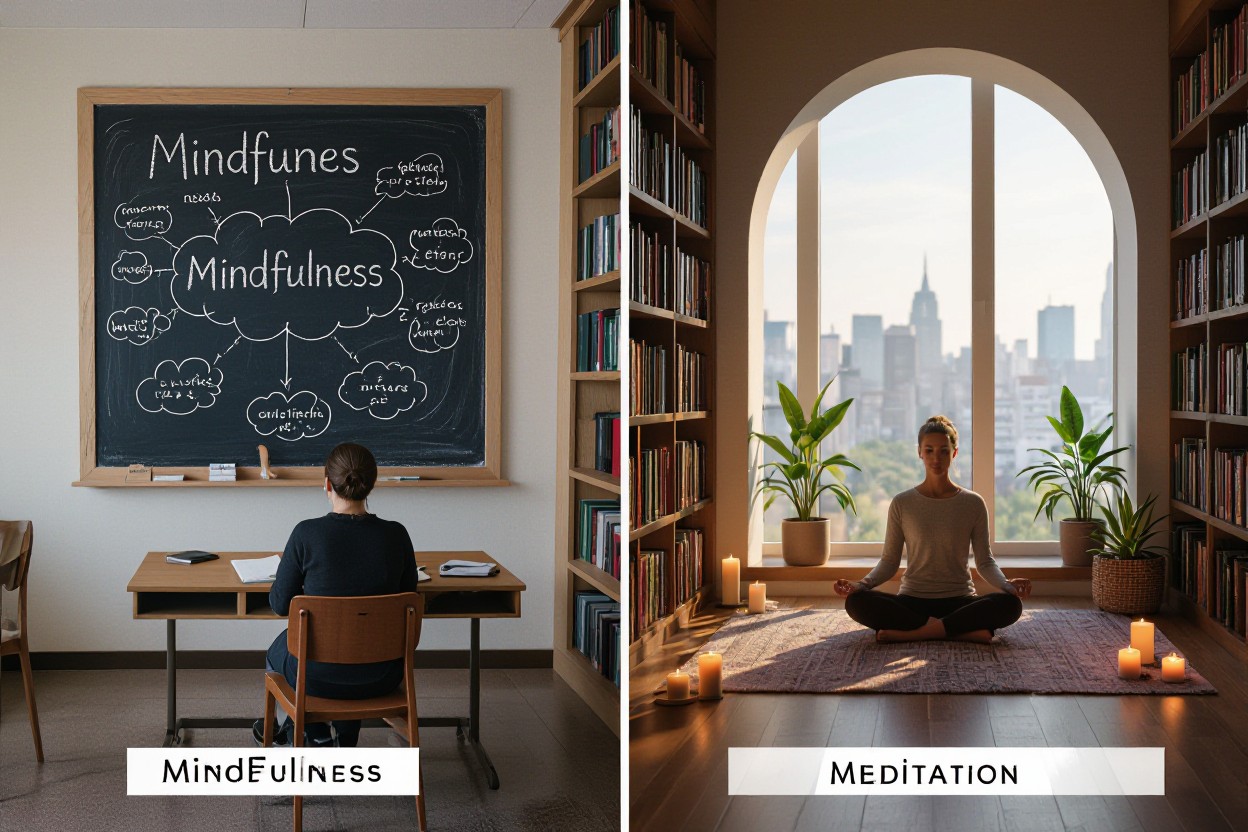Over time, you may have heard the terms mindfulness and meditation used interchangeably, but they actually represent distinct practices with unique benefits. Understanding the difference is crucial to applying them effectively in your daily life. While mindfulness focuses on maintaining present-moment awareness, meditation is a broader set of techniques designed to train your mind. This expert guide will help you navigate these concepts, ensuring you can incorporate the right approach to enhance your mental clarity and emotional well-being.
The Distinctive Elements of Mindfulness and Meditation
Mindfulness and meditation often intertwine, yet they possess distinct qualities that shape their impact. Mindfulness focuses on maintaining a moment-to-moment awareness of your thoughts, feelings, and surroundings without judgment. Meditation, on the other hand, is a broader practice encompassing various techniques aimed at training your attention and awareness, often involving set periods of focused activity. Understanding these differences allows you to select practices that best fit your personal goals, whether seeking stress reduction, improved concentration, or emotional balance.
Definitions That Matter
Mindfulness refers specifically to a mental state characterized by nonjudgmental awareness of the present moment. It occurs continuously as a mode of attention you can cultivate in daily life. Meditation is a structured activity, typically performed sitting quietly, designed to develop concentration, clarity, emotional positivity, and calmness. The dictionary definitions highlight mindfulness as a state, while meditation is noted as a set of techniques—an important distinction that guides how you approach each.
Core Principles and Practices
Mindfulness emphasizes sustained awareness and acceptance of your present experience, encouraging you to observe thoughts and sensations without trying to change them. Meditation practices often include focused attention (such as on the breath), open monitoring, or loving-kindness exercises, each targeting different mental qualities. You might engage in seated meditation for 10–20 minutes daily to train your mind, whereas mindfulness can be integrated seamlessly during routine activities like eating or walking.
Diving deeper, mindfulness capitalizes on a passive observational stance that reduces reactive patterns by fostering acceptance, which neuroscientific studies link to decreased amygdala activation and improved emotional regulation. Meditation, meanwhile, systematically strengthens neural networks associated with attention and self-control through repetitive practice. For example, focused-attention meditation requires redirecting your wandering mind back to a chosen object, reinforcing cognitive discipline, while loving-kindness meditation cultivates empathy and social connectedness. This illustrates how mindfulness and meditation, though interconnected, engage your brain and behavior in distinct yet complementary ways.

The Neurobiology of Mindfulness and Meditation
Exploring the neurobiology behind mindfulness and meditation reveals how these practices reshape your brain over time. Regular engagement can enhance neural connectivity, especially in regions linked to attention, emotional regulation, and self-awareness. Functional magnetic resonance imaging (fMRI) studies demonstrate that sustained mindfulness or meditation practice can increase gray matter density in the hippocampus and prefrontal cortex, areas pivotal for memory and executive function. This neural plasticity underlines why consistent practice can lead to lasting cognitive and emotional benefits.
Brain Activation Patterns
During mindfulness and meditation, your brain displays distinctive activation patterns. Meditation often boosts activity in the prefrontal cortex and anterior cingulate cortex, supporting focused attention and conflict monitoring. Additionally, default mode network (DMN) activity—linked to mind-wandering and self-referential thinking—tends to decrease, helping you maintain present-moment awareness. Notably, experienced practitioners show more efficient DMN deactivation, indicating improved capacity for sustained focus and reduced rumination.
Physiological Effects on Stress and Anxiety
Mindfulness and meditation significantly influence your body’s stress response by modulating the hypothalamic-pituitary-adrenal (HPA) axis, lowering cortisol levels. This hormonal adjustment reduces physiological markers of anxiety, such as heart rate and blood pressure, creating a calmer internal state. Research highlights that even short-term mindfulness meditation can lead to measurable decreases in stress hormones, supporting its role in anxiety management.
Diving deeper, a 2018 meta-analysis examining over 3000 participants revealed that mindfulness practices reduced cortisol levels by an average of 23%, with notable improvements in heart rate variability, a key indicator of autonomic nervous system balance. These physiological changes are accompanied by altered amygdala responsiveness, diminishing your brain’s reactive fear response. Such findings emphasize how mindfulness and meditation promote resilience not only mentally but through concrete changes to your body’s stress systems.

Mindfulness: The Everyday Practice
Mindfulness stretches beyond formal meditation sessions, weaving into your daily routine by bringing full attention to the present moment. Even simple acts like eating, walking, or washing dishes become opportunities to engage your senses actively, noticing textures, smells, and sounds without distraction. This ongoing, moment-to-moment awareness grounds you in reality, reducing automatic reactions and enhancing your emotional resilience during stressful encounters at work or home.
Integrating Mindfulness into Daily Life
You can incorporate mindfulness by setting intentional reminders or creating micro-moments of awareness throughout the day. For example, pause for a few conscious breaths before answering emails or during traffic stops. Apps like Headspace suggest brief “mindful check-ins,” which encourage quick sensory observations, helping you reset and maintain calm focus between tasks without interrupting your workflow.
Benefits Beyond the Cushion
Regular mindfulness practice translates into notable improvements in mental clarity, emotional regulation, and stress reduction. Research from Johns Hopkins highlights mindfulness’s role in mitigating anxiety and depression by reshaping brain areas linked to attention and emotion. These benefits sustain your well-being far beyond formal practice, empowering you to navigate challenging interactions and sustain better sleep patterns.
Delving deeper, a 2018 study in the Journal of Occupational Health Psychology found employees practicing daily mindfulness reported a 31% decrease in burnout symptoms and a 19% increase in job satisfaction. This suggests mindfulness not only enhances your personal resilience but also boosts productivity and workplace relationships, illustrating how consistent practice fosters a healthier, more balanced lifestyle both inside and outside the meditation cushion.
Meditation: A Deeper Dive into Focused Techniques
Diving deeper into meditation unveils a vast landscape of focused exercises designed to refine your attention and cultivate inner stillness. Unlike mindfulness, which often emphasizes present-moment awareness in everyday activities, meditation sets aside dedicated time to engage in specific practices—like breath control, mantra repetition, or visualization. These methods train your brain to reduce distractions, enhance cognitive control, and foster emotional resilience. Engaging consistently can reshape neural pathways, enhancing areas responsible for sustained attention and emotional regulation.
Various Forms of Meditation Explained
Several meditation styles cater to different goals and preferences. Concentrative meditation asks you to fixate on a single object or thought, such as your breath or a candle flame, anchoring your mind amidst distractions. In contrast, open-monitoring meditation encourages observing sensations and thoughts without attachment, promoting broader awareness. Practices like loving-kindness meditation cultivate compassion through focused phrases, while transcendental meditation uses specific mantras to quiet the mind. Understanding these forms can help you choose the technique that resonates best with your mindset and lifestyle.
The Effects of Long-Term Practice
Consistent meditation practice over months and years leads to measurable changes in brain structure and function. Studies using MRI scans reveal increased gray matter density in the hippocampus, improving memory and learning, while the amygdala—key in processing stress—often shows reduced volume and activity. You may notice enhanced emotional regulation, reduced anxiety levels, and sustained improvements in concentration and creativity. These benefits extend beyond the cushion, transforming your daily experiences and reactions.
Extending your practice for a year or more doesn’t just offer momentary calm—it fundamentally alters your brain’s wiring. Neuroplasticity allows meditation to strengthen networks related to self-awareness and executive function, resulting in improved decision-making skills and greater emotional resilience. Longitudinal studies involving practitioners of mindfulness-based stress reduction (MBSR) report significant drops in cortisol, a stress hormone, contributing to better overall health. These physiological changes align with reported increases in feelings of well-being and life satisfaction, providing a compelling case for meditation as a lifelong habit.

Analysing the Misconceptions Around Mindfulness and Meditation
Debunking Common Myths
Many people assume mindfulness and meditation are synonymous, but that oversimplifies their unique functions. Mindfulness is often mistaken as just a relaxation tool, while meditation is viewed solely as a spiritual practice. In truth, mindfulness can be practiced outside formal meditation, such as during everyday activities like eating or walking. Meditation techniques vary widely—from focused-attention to loving-kindness meditation—and not all require sitting still or clearing your mind completely. These myths can hinder you from experiencing the breadth of benefits these practices offer, including improved attention, emotional regulation, and stress reduction.
Understanding the Realities and Limitations
Neither mindfulness nor meditation serve as instant remedies for all mental health issues. While they can reduce stress and enhance well-being, they don’t replace professional therapy or medical treatment for conditions like anxiety or depression. Neuroscientific studies show benefits accumulate gradually, often over months of consistent practice. You may also encounter challenges such as uncomfortable emotions or restlessness during sessions, which can feel discouraging. Recognizing these realities helps you approach your practice with patience and realistic expectations.
Expanding on limitations, research from the American Psychological Association highlights how mindfulness can sometimes increase awareness of negative thoughts, intensifying distress for some practitioners without proper guidance. Additionally, the commercial boom around mindfulness apps and workshops often markets quick fixes, which may lead you to expect immediate results. A grounded understanding acknowledges that both mindfulness and meditation are skills developed over time requiring commitment, and that they work best when integrated into a holistic approach to mental and emotional health.
Conclusion
To wrap up, understanding the difference between mindfulness and meditation empowers you to choose the right approach for your needs. Mindfulness is the practice of being fully present in the moment throughout your daily life, while meditation is a structured technique to develop this awareness. By integrating mindfulness into your routine or dedicating time to meditation sessions, you can enhance your mental clarity, reduce stress, and cultivate greater emotional balance. Both practices complement each other, offering you effective tools to nurture your overall well-being and resilience.





Leave a comment